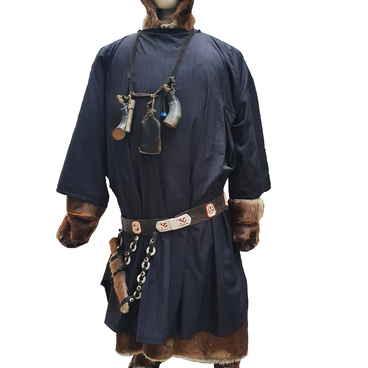The Nenets, Khanty, and Mansi people call traditional winter shoes with fur soles “kisy”. Kisy are made from skins taken from deer legs, which are sewn with threads from deer tendons.
The skin from the shin, from which the kisy are sewn, is called “kamus”. The northern peoples make their traditional shoes only from kamus because it is a very durable material that perfectly retains heat. It takes from eight to thirteen kamuses to make one pair of kisy.
Firstly, the skin goes through several stages of processing. The kamus is stretched, frozen, soaked, dried, aged with a mixture containing deer liver, and carefully pressed. Only after these procedures, it becomes a ready material.
Before sewing, the skins are carefully selected by color and texture so that the right boot does not differ from the left. After that, they are sewn from the inside out with threads from deer tendons. At the same time, the kamus must be sewn with the pile down to avoid water and snow getting inside.
The dense and multi-layered sole of the kisy is made of felt or the part of the skin between the hooves of a deer. This type of hair is stiff, that is why the snow does not stick to it. To regulate the temperature and humidity, insoles made of dried grass are placed inside the boots. For extra warmth, there are stockings made of deer wool, which are called “chizh” among the northern peoples. With proper shoe care, the kisy can be worn for more than ten years.
The boots are richly decorated with vertical colored ornaments. The front part is decorated with pieces of fur and multicolored cloth. Kisy that are made of pure white kamus are highly valued.
Men’s footwear is traditionally decorated more modestly than that of the women. While women’s kisy are usually decorated with beads or colored fur ornaments, the men’s ones most often have a strip of leather and a simple geometric ornament on the top, for example, “deer trail”. The patterns of the peoples of the North consist of simple figures, each of which has its sacred meaning. According to local beliefs, ornaments protect their owner from evil spirits.
Kisy are pulled almost to the waist, fastened to the belt, and tied with special garters under the knees.
The skin from the shin, from which the kisy are sewn, is called “kamus”. The northern peoples make their traditional shoes only from kamus because it is a very durable material that perfectly retains heat. It takes from eight to thirteen kamuses to make one pair of kisy.
Firstly, the skin goes through several stages of processing. The kamus is stretched, frozen, soaked, dried, aged with a mixture containing deer liver, and carefully pressed. Only after these procedures, it becomes a ready material.
Before sewing, the skins are carefully selected by color and texture so that the right boot does not differ from the left. After that, they are sewn from the inside out with threads from deer tendons. At the same time, the kamus must be sewn with the pile down to avoid water and snow getting inside.
The dense and multi-layered sole of the kisy is made of felt or the part of the skin between the hooves of a deer. This type of hair is stiff, that is why the snow does not stick to it. To regulate the temperature and humidity, insoles made of dried grass are placed inside the boots. For extra warmth, there are stockings made of deer wool, which are called “chizh” among the northern peoples. With proper shoe care, the kisy can be worn for more than ten years.
The boots are richly decorated with vertical colored ornaments. The front part is decorated with pieces of fur and multicolored cloth. Kisy that are made of pure white kamus are highly valued.
Men’s footwear is traditionally decorated more modestly than that of the women. While women’s kisy are usually decorated with beads or colored fur ornaments, the men’s ones most often have a strip of leather and a simple geometric ornament on the top, for example, “deer trail”. The patterns of the peoples of the North consist of simple figures, each of which has its sacred meaning. According to local beliefs, ornaments protect their owner from evil spirits.
Kisy are pulled almost to the waist, fastened to the belt, and tied with special garters under the knees.

